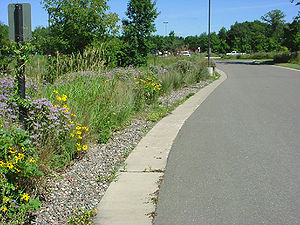
Difference between revisions of "Infiltration"
m |
m |
||
| Line 9: | Line 9: | ||
<font size=3>Infiltration articles</font size> | <font size=3>Infiltration articles</font size> | ||
*[[Overview for infiltration]] | *[[Overview for infiltration]] | ||
| − | *[[Types of infiltration]] | + | *[[BMPs for stormwater infiltration|Types of infiltration]] |
*[[Design criteria for infiltration]] | *[[Design criteria for infiltration]] | ||
*[[Construction specifications for infiltration]] | *[[Construction specifications for infiltration]] | ||
Revision as of 13:41, 1 August 2016
This site is currently undergoing revision. For more information, open this link.
We are in the process of constructing this new page called Infiltration, which will include information on infiltration trenches, infiltration basins, dry wells, and underground infiltration practices. When complete, this page and the accompanying pages shown below will replace the Infiltration trench and Infiltration basin sections of the manual. We anticipate having this completed by late summer. In the interim, please visit the existing pages shown in the links above.
We are in the process of constructing this new page called Infiltration, which will include information on infiltration trenches, infiltration basins, dry wells, and underground infiltration practices. When complete, this page and the accompanying pages shown below will replace the Infiltration trench and Infiltration basin sections of the manual. We anticipate having this completed by late summer. In the interim, please visit the existing pages shown in the links above.
Infiltration basins, infiltration trenches, dry wells, and underground infiltration systems capture and temporarily store stormwater before allowing it to infiltrate into the soil. As the stormwater penetrates the underlying soil, chemical, biological and physical processes remove pollutants and delay peak stormwater flows.
These four practices are grouped together because design, construction, operation, and maintenance guidelines and specifications are similar. Differences between these practices, where they exist, are highlighted on each of the following pages. For additional information on other infiltration practices, see Stormwater infiltration Best Management Practices and Bioretention terminology.
Infiltration articles
- Overview for infiltration
- Types of infiltration
- Design criteria for infiltration
- Construction specifications for infiltration
- Operation and maintenance of infiltration
- Assessing the performance of infiltration
- Calculating credits for infiltration
- Cost-benefit considerations for infiltration
- Case studies for infiltration
- External resources for infiltration
- References for infiltration
- Requirements, recommendations and information for using infiltration basin/underground infiltration BMPs in the MIDS calculator
Related pages
- Understanding and interpreting soils and soil boring reports for infiltration BMPs
- Determining soil infiltration rates
- Cold climate considerations for infiltration practices - See [1], [2]
